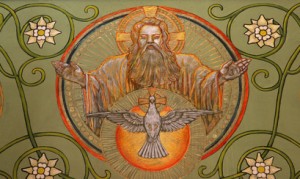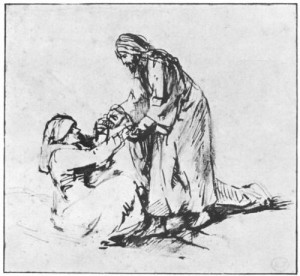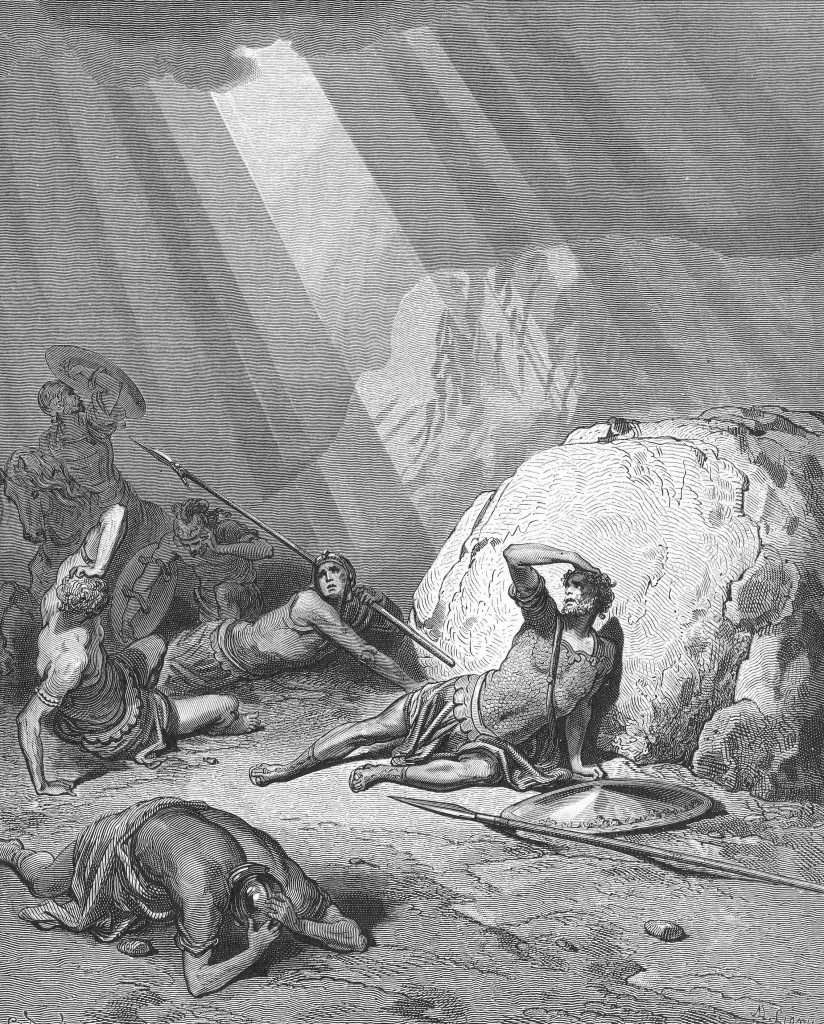====================
A sermon offered on the Third Sunday in Lent, March 8, 2015, to the people of St. Paul’s Episcopal Church, Medina, Ohio, where Fr. Funston is rector.
(The lessons for the day were Exodus 20:1-17; Psalm 19; 1 Corinthians 1:18-25; and John 2:13-22. These lessons can be read at The Lectionary Page.)
====================
 Today is the Third Sunday in Lent but, being March 8, it is also the day set aside on the calendar (both that of the Church of England and that of the Episcopal Church) for us to remember a hero of the Anglican tradition, a World War I chaplain named Geoffrey Anketell Studdert-Kennedy. In 1914 he became the vicar of St. Paul’s, Worcester, UK, but a short while later, on the outbreak of war, Kennedy volunteered as a chaplain to the armed forces. He gained the nickname “Woodbine Willie,” for his practice of giving out Woodbine brand cigarettes to soldiers. In 1917, he won the United Kingdom’s Military Cross for bravery at Messines Ridge.
Today is the Third Sunday in Lent but, being March 8, it is also the day set aside on the calendar (both that of the Church of England and that of the Episcopal Church) for us to remember a hero of the Anglican tradition, a World War I chaplain named Geoffrey Anketell Studdert-Kennedy. In 1914 he became the vicar of St. Paul’s, Worcester, UK, but a short while later, on the outbreak of war, Kennedy volunteered as a chaplain to the armed forces. He gained the nickname “Woodbine Willie,” for his practice of giving out Woodbine brand cigarettes to soldiers. In 1917, he won the United Kingdom’s Military Cross for bravery at Messines Ridge.
He was, additionally, a poet and an author of Christian social critique. We will sing one of his poems as our offertory presentation hymn this morning. (Not Here for High and Holy Things, Hymn No. 9, in the Episcopal Church’s Hymnal 1982.) Among his works of social criticism is one entitled Democracy and the Dog Collar published in 1921. It is an imagined conversation between a representative of “Organized Religion” and one from “Organized Labour” which was just then getting a strong foothold in Britain. In the introductory chapter, he wrote these words:
God is the great politician. He is out to build a City — the new Jerusalem — and He has to work through subordinates and trust them. We are all His subordinates, some of us knaves and some of us fools (perhaps most of us rum mixtures of the two), but we are all He has got to work with and we all must play our part, we must all be politicians. That’s the essence of Democracy, and with all my heart I believe that the City of God is to be a democracy. It would be tidier, more efficient, and less noisy if it were to be built as an autocracy or an oligarchy; but from what I can make out, God is not out for tidiness (if He is He has scored a failure so far, for this world is about the untidiest place I have ever been in — save us, what a muddle it all is!), or efficiency or silence, God is out for life. That is why He is a democrat, and would rather see a world of fat-headed, blundering, vicious fools that are free than a world of strong, silent super-men that are slaves. If you want to save your soul alive you have got to be a politician — a builder of the City of God — there is no other way. (pp 4-5)
I want neither to endorse nor to debate Studdert-Kennedy’s politics, but I do want to say that I think he is absolutely correct when he says that every Christian must be a politician and, a little later in the book, when he writes, “We cannot have any truck with this travesty of Christ’s truth which would bid His servants save their souls and leave their brothers to be damned. Christianity has to do with politics, in fact it is politics — the politics of God.” (p. 6) What I understand him to mean by that is that Christianity, indeed religion in general, is all relationship. The term “politics” at its most basic means “the complex or aggregate of relationships of people in society.”
Today, we have had a reading from Exodus in which we heard that familiar list of ten items popularly and traditionally known to Christians as “The Ten Commandments.” To Jews, however, they are known as Aseret ha-Dibrot, a phrase more accurately translated as “the Ten Sayings,” or “the Ten Statements,” or “the Ten Declarations,” or “the Ten Words,” but not as “the Ten Commandments,” which would be Aseret ha-Mitzvot. These Ten Declarations form the very basic politics, the basic societal relationships of the Judaism from which our faith sprung and which our Lord famously summarized in this manner:
Thou shalt love the Lord thy God with all thy heart, and with all thy soul, and with all thy mind. This is the first and great commandment. And the second is like unto it: Thou shalt love thy neighbor as thyself. On these two commandments hang all the Law and the Prophets. (Mt 22:37-40, quoted in The Book of Common Prayer 1979, page 319)
Now, traditionally these “Commandments” are considered to be what is called “apodictic law,” which means that which is “absolutely certain or necessary.” The Decalogue (another name for the Ten Commandments, a Greek word meaning Ten Laws) is seen to be the basic foundation upon which was built the more detailed instructions of the whole Mosaic Law that follows in Exodus, Numbers, Leviticus, and Deuteronomy. Those 613 detailed mandates, or mitzvot, are the Law Jesus referred to as “hanging” on the two Great Commandments.
Tom Long, a Presbyterian seminary professor, once wrote of the Decalogue:
In the popular religious consciousness, the Ten Commandments have somehow become burdens, weights and heavy obligations. For many, the commandments are encumbrances placed on personal behavior. Most people cannot name all ten, but they are persuaded that at the center of each one is a finger-wagging “thou shalt not.” For others, the commandments are heavy yokes to be publicly placed on the necks of a rebellious society. (Dancing the Decalogue)
But as I was studying the Scriptures for this sermon, I learned two things about these passage from Exodus: one that I had known and forgotten, and one I’d never known before.
The former is that the articles of the Decalogue are numbered differently among the religious traditions. Jews number the Ten Sayings differently from Christians and – among Christians – Roman Catholics, the Orthodox, and Lutherans number them differently than do Anglicans, the Reformed Churches, and other Protestants. That really is a minor matter inasmuch as we all eventually get to the same bottom line, except for this – Jews separately enumerate the first several words of what we historically call “the first commandment” and make it an introductory comment to the entire set.
Take a look at page 350 in The Book of Common Prayer 1979. This is the contemporary English version of the Decalogue (there is a Jacobean English version beginning on page 317). Notice the way it begins: “Hear the commandments of God to his people:” and then follows what we have always taken to be the first commandment: “I am the Lord your God who brought you out of bondage. You shall have no other gods but me.” In the Jewish understanding, that first sentence is not part of the first commandment. And, truly, it is not a commandment at all; rather, it is the statement of a relationship out of which all that follows flows.
God first establishes God’s relationship with the People; what follows is a description of the behavior of a free people, people whom God has freed “out of the land of Egypt, out of the house of slavery.” As Tom Long puts it, “Understanding the Decalogue as a set of burdens overlooks something essential, namely that they are prefaced not by an order – ‘Here are ten rules. Obey them!’ – but instead by a breathtaking announcement of freedom.” These people may be, as Studdert-Kennedy remarked, “fat-headed, blundering, vicious fools,” but they are free and in their freedom, if they are in this right relationship with God, this is how they will behave: they will worship God and no other; they will keep the Sabbath; they will honor their elders; they will not commit murder or adultery; and so forth.
The second thing I learned is that at least some, if not all, of the so-called commandments are stated in a Hebraic verb form called “the infinitive absolute.” There’s nothing quite like it in English grammar. It is a verb form that, while it can be used for mandates and instructions, is most often used for prophecies!
Putting these two learnings together, I have come to the conclusion that these “ten words” are better thought of, not as “ten commandments,” but as the “ten predictions.” It’s not a case of “because I am your God you will do this” but rather “because I am your God you will do this.” God does not give the law as a means to salvation; the “ten words” are not conditions precedent, which is what commandments are: “If you do these things, then God will be your God” (and if you don’t . . . well, then, watch out!) They are, rather, statements of what happens simply because God is our God; they are predictions of what naturally follows from that relationship. The relationship comes first and this manner of life is the outcome. Lutheran theologian James Arne Nestingen has said that the Ten Commandments are “gifts of redemption, a gracious bequeathal given in the course of release from bondage,” (Word & World) or as my friend and colleague Peggy Blanchard said, “The Decalogue is not a prescription but a description.”
If the ten articles of Exodus 20 are “laws,” they are more like the laws of nature than like statutes. They are statements of the uniformities and regularities in the world, descriptions of the way the world is, principles which govern the phenomena of existence. Add two to two and you get four. Drop an object from a tall building and it will accelerate toward the ground at a rate of 9.8 meters per second squared.
Our saint-of-the-day, Geoffrey Studdert-Kennedy, in another of his books wrote:
A man cannot act right unless he believes right, because men always act according to their belief. A man may not act according to the belief he professes, but he will always act according to the belief he really holds — he cannot help it. * * * A man must always act upon his neighbour according to his master-passion — his real belief. He must always love his neighbour as he loves his God. That your love of your neighbour depends for its force on the love of your God is not a Christian dogma but a law of social life, as the law of gravity is of natural life, just as universal and just as inevitable. (Lies!, 1919, pp. 109, 111)
Love God, love your neighbor, “on these two commandments hang all the Law and the Prophets.” Be in a right relationship with your God and you will behave as described in Exodus 20; it is “a law of social life, as the law of gravity is of natural life, just as universal and just as inevitable.”
To quote Tom Long one last time, “The good news of the God who set people free is the music; the commandments are the dance steps of those who hear it playing. The commandments are not weights, but wings that enable our hearts to catch the wind of God’s Spirit and to soar.” Remember what the Psalmist wrote:
The law of the Lord is perfect and revives the soul;
the testimony of the Lord is sure and gives wisdom to the innocent.
The statutes of the Lord are just and rejoice the heart;
the commandment of the Lord is clear and gives light to the eyes. (Ps. 19:7-8, BCP Version)
Be in that right relationship with God and you will be revived, you will be given wisdom, your heart will rejoice, you will catch the wind of God’s Spirit and soar; hear the music of the good news and you will dance. Amen.
====================
A request to my readers: I’m trying to build the readership of this blog and I’d very much appreciate your help in doing so. If you find something here that is of value, please share it with others. If you are on Facebook, “like” the posts on your page so others can see them. If you are following me on Twitter, please “retweet” the notices of these meditations. If you have a blog of your own, please include mine in your links (a favor I will gladly reciprocate). Many thanks!
====================
Father Funston is the rector of St. Paul’s Episcopal Church, Medina, Ohio.
 I was an English and American literature major in college (well, I finished as an English literature major – I was a biology major, a sociology major, an anthropology major, a philosophy major, and an undeclared major before ending up with a degree in literature.) I remember a certain type of end-of-term take home exam, the compare-and-contrast question. For instance, you’d read a bunch of novels and then along would come the final exam with a question like, “Compare and contrast the vision of the sea in Hemingway’s
I was an English and American literature major in college (well, I finished as an English literature major – I was a biology major, a sociology major, an anthropology major, a philosophy major, and an undeclared major before ending up with a degree in literature.) I remember a certain type of end-of-term take home exam, the compare-and-contrast question. For instance, you’d read a bunch of novels and then along would come the final exam with a question like, “Compare and contrast the vision of the sea in Hemingway’s  What is Lent all about?
What is Lent all about? “Life is a banquet, and most poor suckers are starving to death!”
“Life is a banquet, and most poor suckers are starving to death!”  After I did my first sermon-prep read through of this morning’s gospel I thought, “There are two stories here.” Then I thought, “No, there are three.” And then I realized that there are really more stories here than I can count.
After I did my first sermon-prep read through of this morning’s gospel I thought, “There are two stories here.” Then I thought, “No, there are three.” And then I realized that there are really more stories here than I can count.  “I heard a voice saying in Hebrew: ‘I have a job for you. I’ve handpicked you to be a servant and witness to what’s happened today, and to what I am going to show you. I’m sending you off to open the eyes of the outsiders so they can see the difference between dark and light, and choose light, see the difference between Satan and God, and choose God.'” (Acts 26:16-18a, The Message)
“I heard a voice saying in Hebrew: ‘I have a job for you. I’ve handpicked you to be a servant and witness to what’s happened today, and to what I am going to show you. I’m sending you off to open the eyes of the outsiders so they can see the difference between dark and light, and choose light, see the difference between Satan and God, and choose God.'” (Acts 26:16-18a, The Message)  Tonight we gather once again to celebrate a memory, the memory of the birth of Christ, the Christ who is about to be born again as he is every year. We don’t really know if he was born at this time of the year; in fact, most scholars agree he wasn’t. But that doesn’t matter. It isn’t the date that we celebrate; it is his birth, then and in our lives each time we remember.
Tonight we gather once again to celebrate a memory, the memory of the birth of Christ, the Christ who is about to be born again as he is every year. We don’t really know if he was born at this time of the year; in fact, most scholars agree he wasn’t. But that doesn’t matter. It isn’t the date that we celebrate; it is his birth, then and in our lives each time we remember.
 When Philip told Nathanael that he had found the Messiah and that he was the son of a carpenter from Nazareth, Nathanael’s immediate response was, “Can anything good come from Nazareth?” (Jn 1:46). Obviously Nazareth had a reputation, and not a good one. I often wonder if, as Jesus was making his way through the Holy Land, especially early in his ministry when he wasn’t well-known, people would ask him, “What was it like growing up in Nazareth?”
When Philip told Nathanael that he had found the Messiah and that he was the son of a carpenter from Nazareth, Nathanael’s immediate response was, “Can anything good come from Nazareth?” (Jn 1:46). Obviously Nazareth had a reputation, and not a good one. I often wonder if, as Jesus was making his way through the Holy Land, especially early in his ministry when he wasn’t well-known, people would ask him, “What was it like growing up in Nazareth?”

